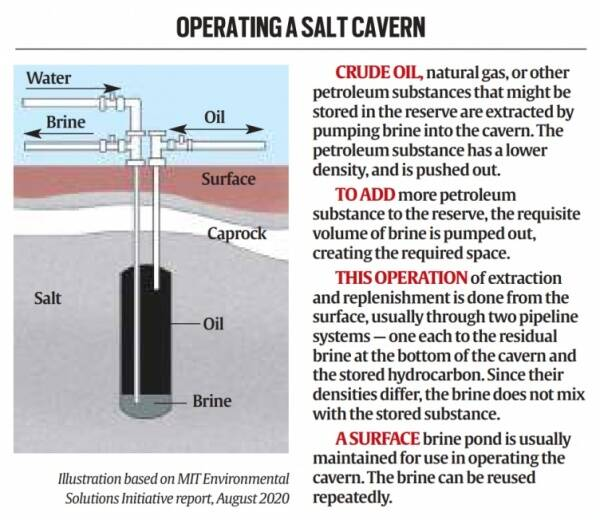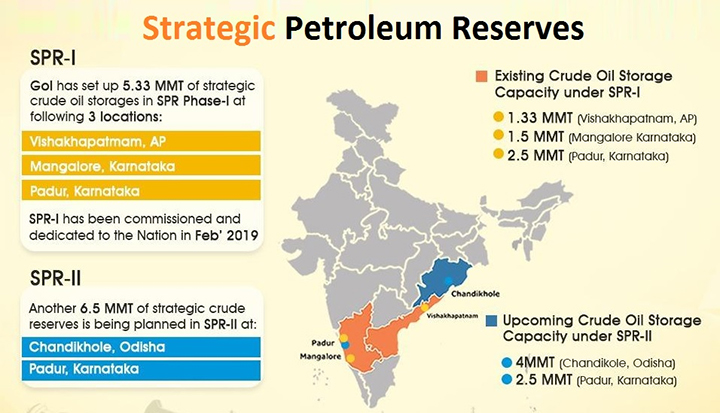Economy
Salt Cavern Based Oil Reserves: SPR
- 05 Jun 2023
- 8 min read
For Prelims: Salt Cavern Based Oil Reserves, Rock Based Cavern, Strategic Petroleum Reserve Program, IEA, PPP.
For Mains: Advantage of Salt Cavern Based Oil Reserves over Rock Based Cavern and its Potential.
Why in News?
Government-owned engineering consultancy firm Engineers India Ltd. (EIL) is studying the prospects and feasibility of developing Salt Cavern-Based Strategic oil Reserves in Rajasthan.
- The study is in line with the government’s objective of increasing the country’s strategic oil storage capacity.
What is Salt Cavern-based Reserves?
- About:
- Salt caverns are underground spaces formed by dissolving salt in water through a process called solution mining.
- This method involves pumping water into areas with large salt deposits to dissolve the salt and create caverns. Once the brine (water with dissolved salt) is removed, these caverns can be used to store crude oil.
- Rock Based Cavern:
- Excavated rock-based caverns for oil reserves are underground spaces created by manually excavating and removing rock materials to form large storage cavities.
- Excavated rock caverns are constructed by drilling, blasting, and removing rock layers to create the desired storage space. The rock walls and ceilings of these caverns serve as the natural barriers for containing the stored oil.
- Significance of Salt Based-Cavern Over Rock Based Cavern:
- Salt cavern development is simpler, faster, and less expensive. Salt cavern-based oil storage facilities are naturally well-sealed and designed for efficient oil injection and extraction.
- A report by MIT's Environmental Solutions Initiative suggests that storing oil in salt caverns is more favorable than other geological formations.
- The salt lining the caverns has very low oil absorbency, creating a natural impermeable barrier against liquid and gaseous hydrocarbons. This characteristic makes salt caverns suitable for oil storage.
- The United States' Strategic Petroleum Reserve (SPR), the largest emergency oil storage globally, relies exclusively on salt cavern-based facilities.
- Potential of Salt Based Cavern:
- Salt cavern-based storage, which is considered cheaper and less labour- and cost-intensive than rock caverns, could add a new, much-needed chapter to India’s SPR story.
- Rajasthan, with its abundant salt formations, is considered the most suitable location in India for developing salt cavern-based strategic storage facilities.
- The presence of a refinery in Barmer and crude oil pipelines in Rajasthan makes the infrastructure conducive for building strategic oil reserves.
What are the Challenges to Build a Salt Based Cavern for Oil Reserves?
- Indian companies have lacked the technical expertise required to construct salt cavern-based strategic storage facilities.
- However, EIL has recently partnered with Germany, a company specializing in cavern storage and solution mining technology, to bridge this knowledge gap.
- Identifying suitable sites for salt cavern-based storage facilities is crucial. While Rajasthan has abundant salt formations and favorable infrastructure such as crude pipelines and a new refinery in Barmer, specific sites within the region need to be assessed for their geological and technical suitability.
- Estimating the project cost is a challenge until the technology and knowledge required for building salt cavern-based storage facilities are obtained. Factors such as site preparation, construction, and operational considerations need to be taken into account, along with other associated costs.
What is India’s Strategic Petroleum Reserves Programme?
- About:
- The construction of the Strategic Crude Oil Storage facilities in India is being managed by Indian Strategic Petroleum Reserves Limited (ISPRL).
- ISPRL is a wholly owned subsidiary of Oil Industry Development Board (OIDB) under the Ministry of Petroleum & Natural Gas.
- Strategic crude oil storages are at Mangalore (Karnataka), Visakhapatnam (Andhra Pradesh) and Padur (Karnataka) as per Phase I. They have fuel storage of total 5. 33 MMT (Million Metric Tonnes).
- The construction of the Strategic Crude Oil Storage facilities in India is being managed by Indian Strategic Petroleum Reserves Limited (ISPRL).
- Additional Reserves under PPP:
- The government of India is planning to set up two more such caverns at Chandikhol (Odisha) and Udupi (Karnataka) as per phase II through Public-Private Partnership. This will give an additional 6.5 million tons of the oil reserves.
- After the new facilities get functional, a total of 22 days (10+12) of oil consumption will be made available.
- Capacity/Industrial Stock:
- With the strategic facilities, Indian refiners also maintain crude oil storage (industrial stock) of 65 days.
- Thus, approximately a total of 87 days (22 by strategic reserves + 65 by Indian refiners) of oil consumption will be made available in India after completion of Phase II of the SPR programme.
- This will be very close to the 90 days mandate by the IEA.
- India became an associate member of the IEA in 2017 and recently, IEA has invited India to become a full time member.
- Need for Expanding the Capacity of SPR:
- India, the world’s third-largest consumer of crude, depends on imports for more than 85% of its requirement — and SPR can help ensure energy security and availability during global supply shocks and other emergencies.
- India is in the process of expanding its SPR capacity by a cumulative 6.5 million tonnes at two locations — Chandikhol in Odisha (4 million tonnes) and Padur (2.5 million tonnes).
- India currently has an SPR capacity of 5.33 million tonnes, or around 39 million barrels of crude, that can meet around 9.5 days of demand.
Way Forward
- Conducting comprehensive geological and technical assessments of potential sites in Rajasthan is crucial.
- Undertaking a comprehensive feasibility study will help evaluate the economic viability and technical feasibility of the project. This assessment should analyze potential risks, project timelines, operational requirements, and long-term sustainability to determine the viability of salt cavern-based storage facilities.
- Exploring public-private partnerships can help reduce government spending and attract private investment in the development of strategic reserves. Leveraging the commercial potential of the reserves through partnerships can enhance the project's feasibility and contribute to economic growth.








